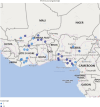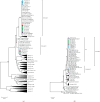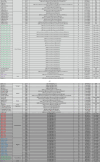Detection of African Swine Fever Virus Genotype II in West Africa (2020) and Its Co-Circulation With Endemic Genotype I: Implications for Pig Production
- PMID: 40529621
- PMCID: PMC12173545
- DOI: 10.1155/tbed/5396227
Detection of African Swine Fever Virus Genotype II in West Africa (2020) and Its Co-Circulation With Endemic Genotype I: Implications for Pig Production
Abstract
African swine fever (ASF) is a highly devastating disease of domestic pigs caused by the ASF virus (ASFV). Historically, only ASFV Genotype I was known to circulate in West Africa. However, Genotype II has recently emerged in Nigeria, Ghana, and Benin for the first time. Between 2017 and 2023, suspected ASF outbreaks were reported in Burkina Faso, Côte d'Ivoire, Nigeria, and Mali. The source, extent, and spread of these ASF outbreaks remain unknown. Samples collected from 2017 to 2023 were analyzed using real-time qPCR and characterized using five ASFV gene segments: partial gene of the B464L (p72), full length E183L (p54), central variable region (CVR) within B602L, EP402R (CD2v), and intergenic region (IGR) between I73R and I329L genes. ASF was confirmed in 12 Nigerian states and in seven, eight, and two provinces of Burkina Faso, Côte d'Ivoire, and Mali, respectively. Phylogenetic analysis of B646L (p72), E183 (p54), and CD2v genes of ASFV revealed that Genotype I, Serogroup 4, caused the initial outbreaks in these countries, followed by Genotype II, Serogroup 8. CVR profile analysis showed ASFV Genotype I with different variants, while Genotype II presented only one CVR variant. This is the first report of ASFV Genotype II in Burkina Faso, Cote d'Ivoire, and Mali. The introduction of ASFV Genotype II and its co-circulation with Genotype I in pig populations in these West African countries threatens food security and complicates control measures. Therefore, increased surveillance at international ports of entry, restrictions on live pig movements within the countries, and improved farm-level biosecurity measures are needed to control the further spread of the disease.
Keywords: CVR variants; food security; p72; phylogenetic analysis; serogroup; surveillance.
Copyright © 2025 Irene Kasindi Meki et al. Transboundary and Emerging Diseases published by John Wiley & Sons Ltd.
Conflict of interest statement
The authors declare no conflicts of interest.
Figures





Similar articles
-
First detection of African swine fever (ASF) virus genotype X and serogroup 7 in symptomatic pigs in the Democratic Republic of Congo.Virol J. 2020 Sep 3;17(1):135. doi: 10.1186/s12985-020-01398-8. Virol J. 2020. PMID: 32883295 Free PMC article.
-
African Swine Fever Virus Circulation between Tanzania and Neighboring Countries: A Systematic Review and Meta-Analysis.Viruses. 2021 Feb 15;13(2):306. doi: 10.3390/v13020306. Viruses. 2021. PMID: 33672090 Free PMC article.
-
First Serologic Analysis of Antibodies Against African Swine Fever Virus Detected in Domestic Pig Farms in South Korea from 2019 to 2024.Pathogens. 2025 Jun 11;14(6):581. doi: 10.3390/pathogens14060581. Pathogens. 2025. PMID: 40559589 Free PMC article.
-
Molecular characterization of African Swine fever viruses in Burkina Faso, Mali, and Senegal 1989-2016: Genetic diversity of ASFV in West Africa.Transbound Emerg Dis. 2021 Sep;68(5):2842-2852. doi: 10.1111/tbed.14240. Epub 2021 Jul 29. Transbound Emerg Dis. 2021. PMID: 34323385
-
Risk factors for the spread of African Swine Fever in China: A systematic review of Chinese-language literature.Transbound Emerg Dis. 2022 Sep;69(5):e1289-e1298. doi: 10.1111/tbed.14573. Epub 2022 May 11. Transbound Emerg Dis. 2022. PMID: 35490407 Free PMC article.
References
-
- Eustace Montgomery R. On A Form of Swine Fever Occurring in British East Africa (Kenya Colony) Journal of Comparative Pathology and Therapeutics . 1921;34:159–191. doi: 10.1016/S0368-1742(21)80031-4. - DOI
MeSH terms
LinkOut - more resources
Full Text Sources

